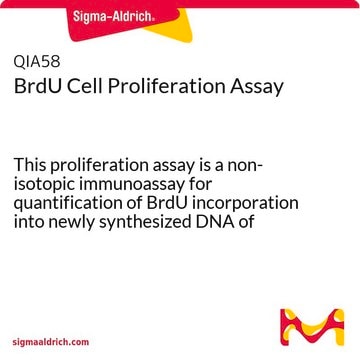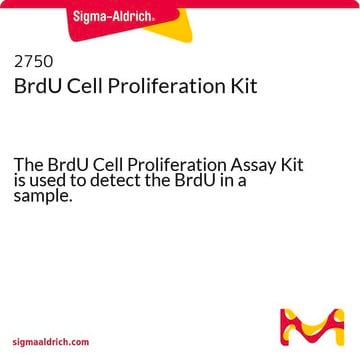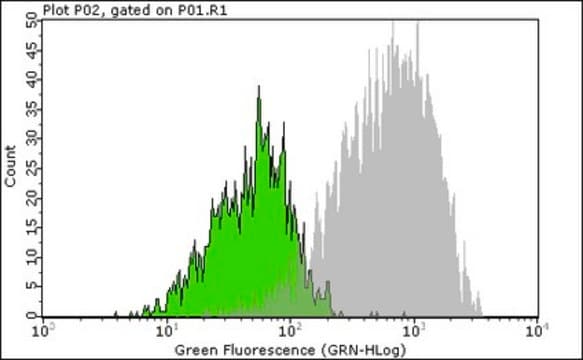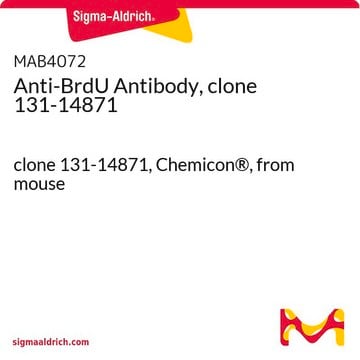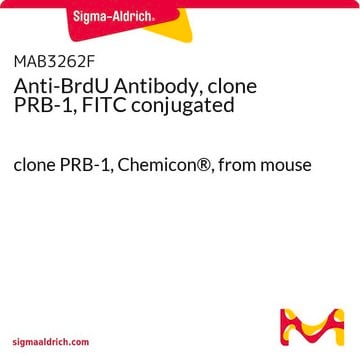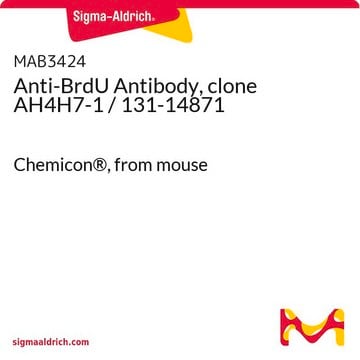19-160
BrdU (5-Bromo-2′-deoxyuridine)
Used for the study of DNA synthesis where it is incorporated into DNA in place of thymidine, BrdU can be used in conjunction with anti-BrdU for immunocytochemical analysis of cell proliferation.
Synonym(s):
Bromodeoxyuridine
Sign Into View Organizational & Contract Pricing
All Photos(1)
About This Item
UNSPSC Code:
41116012
eCl@ss:
32160405
NACRES:
NA.41
Recommended Products
Quality Level
manufacturer/tradename
Upstate®
technique(s)
immunocytochemistry: suitable
shipped in
wet ice
Application
Research Category
All
All
Used for the study of DNA synthesis where it is incorporated into DNA in place of thymidine; BrdU can be used in conjunction with anti-BrdU for immunocytochemical analysis of cell proliferation.
Physical form
C9H11BrN2O5
Storage and Stability
2 years at -20°C
Legal Information
UPSTATE is a registered trademark of Merck KGaA, Darmstadt, Germany
Disclaimer
Unless otherwise stated in our catalog or other company documentation accompanying the product(s), our products are intended for research use only and are not to be used for any other purpose, which includes but is not limited to, unauthorized commercial uses, in vitro diagnostic uses, ex vivo or in vivo therapeutic uses or any type of consumption or application to humans or animals.
Signal Word
Danger
Hazard Statements
Precautionary Statements
Hazard Classifications
Muta. 1B - Repr. 2
Storage Class Code
6.1C - Combustible acute toxic Cat.3 / toxic compounds or compounds which causing chronic effects
WGK
WGK 2
Certificates of Analysis (COA)
Search for Certificates of Analysis (COA) by entering the products Lot/Batch Number. Lot and Batch Numbers can be found on a product’s label following the words ‘Lot’ or ‘Batch’.
Already Own This Product?
Find documentation for the products that you have recently purchased in the Document Library.
Customers Also Viewed
Immunocytochemical detection of S-phase cells in normal and neoplastic cervical epithelium by anti-BrdU monoclonal antibody
Fukuda, K, et al
Analytical and Quantitative Cytology and Histology, 12, 135-138 (1990)
G Cattoretti et al.
The Journal of pathology, 171(2), 83-98 (1993-10-01)
Enzymatic and non-enzymatic treatments for antigen unmasking on formalin-fixed, paraffin-embedded, dewaxed sections were optimized and compared by the use of a panel of antibodies of diagnostic relevance (anti-cytokeratins, vimentin, S-100, T- and B-cell receptors, Ki-67/MIB 1, muscle actin). Non-enzymatic unmasking
Xiaochao Chen et al.
European journal of pharmaceutics and biopharmaceutics : official journal of Arbeitsgemeinschaft fur Pharmazeutische Verfahrenstechnik e.V, 107, 286-294 (2016-07-28)
The purpose of this study was to evaluate whether topical application of superoxide dismutase with cell penetrating peptide (HIV-TAT) could protect against skin damage induced by UVB irradiation in humans. The permeability through stratum corneum of large proteins linked to
Gabriel Schneebauer et al.
Journal of comparative physiology. B, Biochemical, systemic, and environmental physiology, 186(7), 867-877 (2016-05-06)
In a process called silvering, European eels prepare for their long-distance migration from European freshwater systems to the Sargasso Sea for reproduction. During this journey, eels perform extended diel vertical migrations, and the concomitant changes in hydrostatic pressure significantly affect
Sheng-Hua Ying et al.
Scientific reports, 6, 26376-26376 (2016-05-21)
Autophagy-related proteins play significantly different roles in eukaryotes. In the entomopathogenic fungus Beauveria bassiana, autophagy is associated with fungal growth and development. BbATG1 (a serine/threonine protein kinase) and BbATG8 (a ubiquitin-like protein) have similar roles in autophagy, but different roles
Our team of scientists has experience in all areas of research including Life Science, Material Science, Chemical Synthesis, Chromatography, Analytical and many others.
Contact Technical Service

